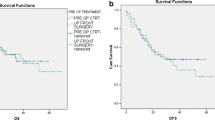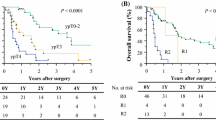Abstract
Background
This study aimed to analyze the effect of preoperative chemoradiation on the adequacy of lymph node dissection.
Methods
Patients with esophageal cancer treated with esophagectomy by the same surgeon between 2004 and 2011 were reviewed. Specimens were examined by the same pathologist. Patients were grouped into two depending on the type of treatment received.
Results
Forty-seven patients with curative esophagectomy were included in the study. Twenty patients had preoperative chemoradiation followed by surgery and 27 had surgery alone. Open and hybrid esophagectomy approaches were used. The average number of lymph nodes dissected was 16 ± 10 (1–39). There was a significant decrease in the number of lymph nodes examined in patients with preoperative chemoradiotherapy in comparison to surgery alone (p = 0.001). Median length of stay was 12 days. R0 resection rate was 96 %. The median survival was 36.3 months, with a 42 % 5-year survival. Seven patients (25 %) had complete pathologic response following chemoradiation. No significant difference was recorded in terms of disease recurrence (p = 0.3). While morbidity was higher in the preoperative therapy group with 30 day mortality of 10 %, type of surgical approach does not seem to influence the number of lymph nodes dissected (p = 0.7).
Conclusions
Preoperative chemoradiation decreases the number of harvested lymph nodes following esophagectomy regardless of the surgical technique used. The optimum number of lymph nodes currently recommended to be dissected for accurate nodal staging and survival needs revision in this group of patients.
Similar content being viewed by others
References
Swanson SJ, Batirel HF, Bueno R et al (2001) Transthoracic esophagectomy with radical mediastinal and abdominal lymph node dissection and cervical esophagogastrostomy for esophageal carcinoma. Ann Thorac Surg 72(6):1918–1924
Kang CH, Kim YT, Jeon S-H et al (2007) Lymphadenectomy extent is closely related to long-term survival in esophageal cancer. Eur J Cardiothorac Surg 31(2):154–160
Lerut T, Coosemans W, Decker G et al (2004) Extended surgery for cancer of the esophagus and gastroesophageal junction. J Surg Res 117(1):58–63
Rizk NP, Ishwaran H, Rice TW et al (2010) Optimum lymphadenectomy for esophageal cancer. Ann Surg 251(1):46–50
Stiles BM, Nasar A, Mirza FA et al (2012) Worldwide Oesophageal Cancer Collaboration guidelines for lymphadenectomy predict survival following neoadjuvant therapy. Eur J Cardiothorac Surg 42(4):659–664
Rizk N, Venkatraman E, Park B et al (2006) The prognostic importance of the number of involved lymph nodes in esophageal cancer: implications for revisions of the American Joint Committee on Cancer staging system. J Thorac Cardiovasc Surg 132(6):1374–1381
Igaki H, Kato H, Tachimori Y, Nakanishi Y (2003) Prognostic evaluation of patients with clinical T1 and T2 squamous cell carcinomas of the thoracic esophagus after 3-field lymph node dissection. Surgery 133(4):368–374
Yang HX, Xu Y, Fu JH et al (2010) An evaluation of the number of lymph nodes examined and survival for node-negative esophageal carcinoma: data from China. Ann Surg Oncol 17(7):1901–1911
Bollschweiler E, Baldus SE, Schroder W et al (2006) Staging of esophageal carcinoma: length of tumor and number of involved regional lymph nodes. Are these independent prognostic factors? J Surg Oncol 94(5):355–363
Groth SS, Virnig BA, Whitson BA et al (2010) Determination of the minimum number of lymph nodes to examine to maximize survival in patients with esophageal carcinoma: data from the Surveillance Epidemiology and End Results database. J Thorac Cardiovasc Surg 139(3):612–620
Altorki NK, Zhou XK, Stiles B et al (2008) Total number of resected lymph nodes predicts survival in esophageal cancer. Ann Surg 248(2):221–226
Habr-Gama A, Perez RO, Proscurshim I et al (2008) Absence of lymph nodes in the resected specimen after radical surgery for distal rectal cancer and neoadjuvant chemoradiation therapy: what does it mean? Dis Colon Rectum 51(3):277–283
Wu ZM, Teng RY, Shen JG et al (2011) Reduced lymph node harvest after neoadjuvant chemotherapy in gastric cancer. J Int Med Res 39(6):2086–2095
Scabini S, Ferrando V (2012) Number of lymph nodes after neoadjuvant therapy for rectal cancer: how many are needed? World J Gastrointest Surg 4(2):32–35
Govindarajan A, Gonen M, Weiser MR et al (2011) Challenging the feasibility and clinical significance of current guidelines on lymph node examination in rectal cancer in the era of neoadjuvant therapy. J Clin Oncol 29(34):4568–4573
Bollschweiler E, Besch S, Drebber U et al (2010) Influence of neoadjuvant chemoradiation on the number and size of analyzed lymph nodes in esophageal cancer. Ann Surg Oncol 17(12):3187–3194
Castoro C, Scarpa M, Cagol M et al (2011) Nodal metastasis from locally advanced esophageal cancer: how neoadjuvant therapy modifies their frequency and distribution. Ann Surg Oncol 18(13):3743–3754
Kesler KA, Helft PR, Werner EA et al (2005) A retrospective analysis of locally advanced esophageal cancer patients treated with neoadjuvant chemoradiation therapy followed by surgery or surgery alone. Ann Thorac Surg 79(4):1116–1121
Marks JH, Valsdottir EB, Rather AA et al (2010) Fewer than 12 lymph nodes can be expected in a surgical specimen after high-dose chemoradiation therapy for rectal cancer. Dis Colon Rectum 53(7):1023–1029
Cserni G, Vinh-Hung V, Burzykowski T (2002) Is there a minimum number of lymph nodes that should be histologically assessed for a reliable nodal staging of T3N0M0 colorectal carcinomas? J Surg Oncol 81(2):63–69
Lou F, Sima CS, Adusumilli PS et al (2013) Esophageal cancer recurrence patterns and implications for surveillance. J Thorac Oncol 8(12):1558–1562
Sugiyama M, Morita M, Yoshida R et al (2012) Patterns and time of recurrence after complete resection of esophageal cancer. Surg Today 42(8):752–758
Nakagawa S, Kanda T, Kosugi S et al (2004) Recurrence pattern of squamous cell carcinoma of the thoracic esophagus after extended radical esophagectomy with three-field lymphadenectomy. J Am Coll Surg 198(2):205–211
Luketich JD, Pennathur A, Awais O et al (2012) Outcomes after minimally invasive esophagectomy: review of over 1000 patients. Ann Surg 256(1):95–103
Conflict of interest
None.
Author information
Authors and Affiliations
Corresponding author
Rights and permissions
About this article
Cite this article
Issaka, A., Ermerak, N.O., Bilgi, Z. et al. Preoperative Chemoradiation Therapy Decreases the Number of Lymph Nodes Resected During Esophagectomy. World J Surg 39, 721–726 (2015). https://doi.org/10.1007/s00268-014-2847-x
Published:
Issue Date:
DOI: https://doi.org/10.1007/s00268-014-2847-x




